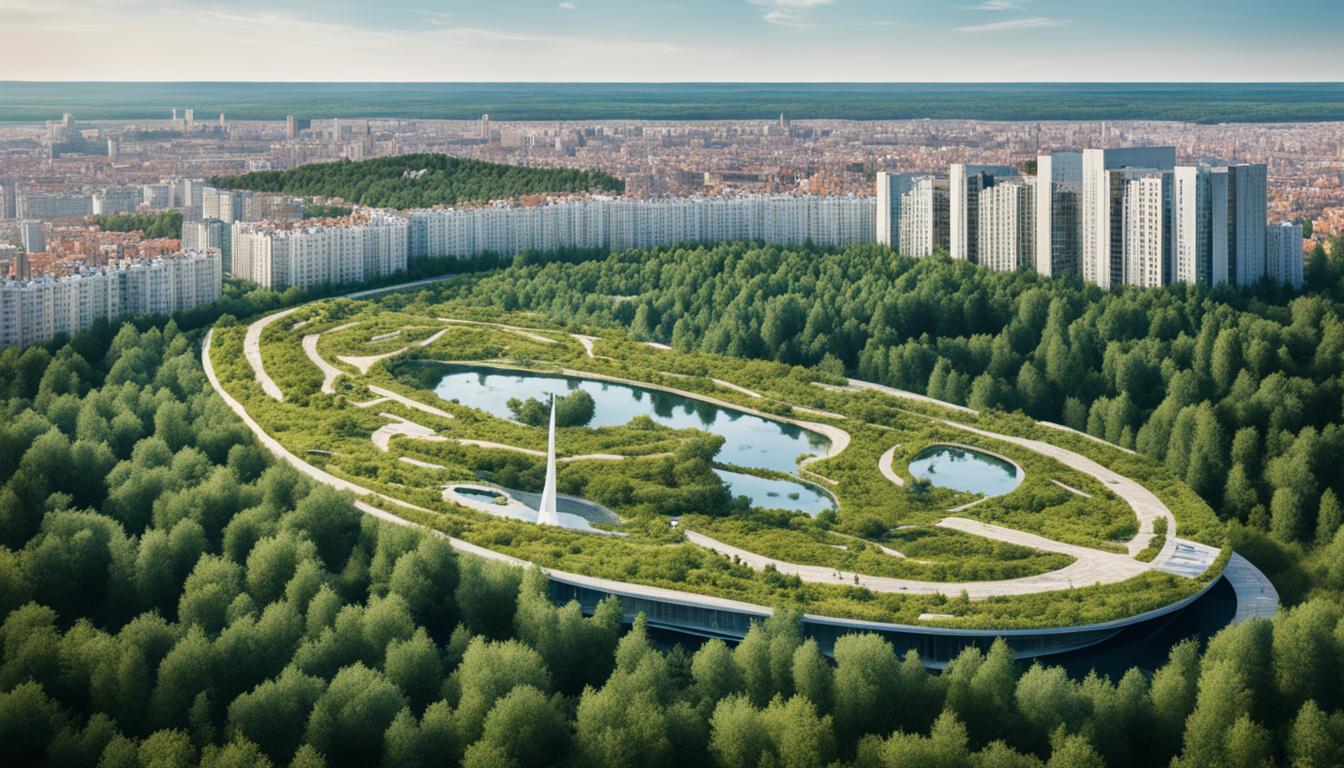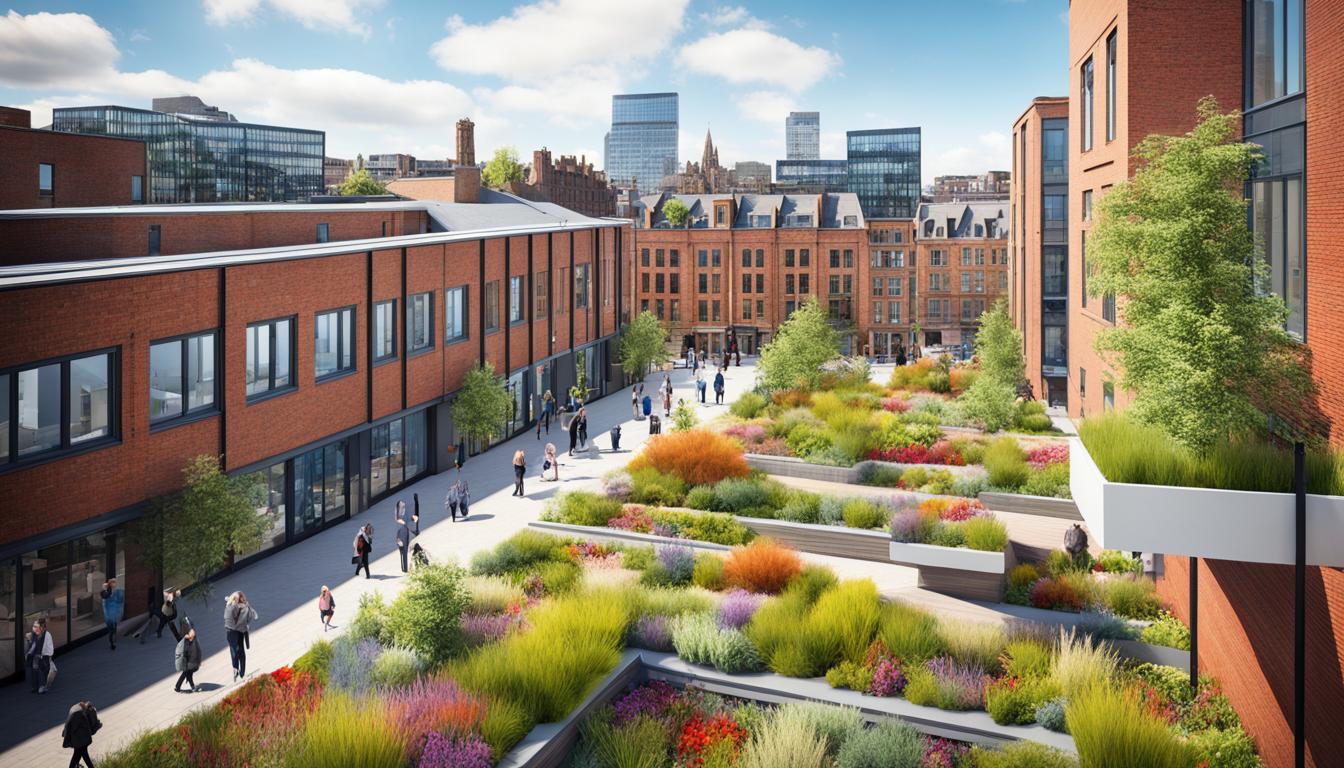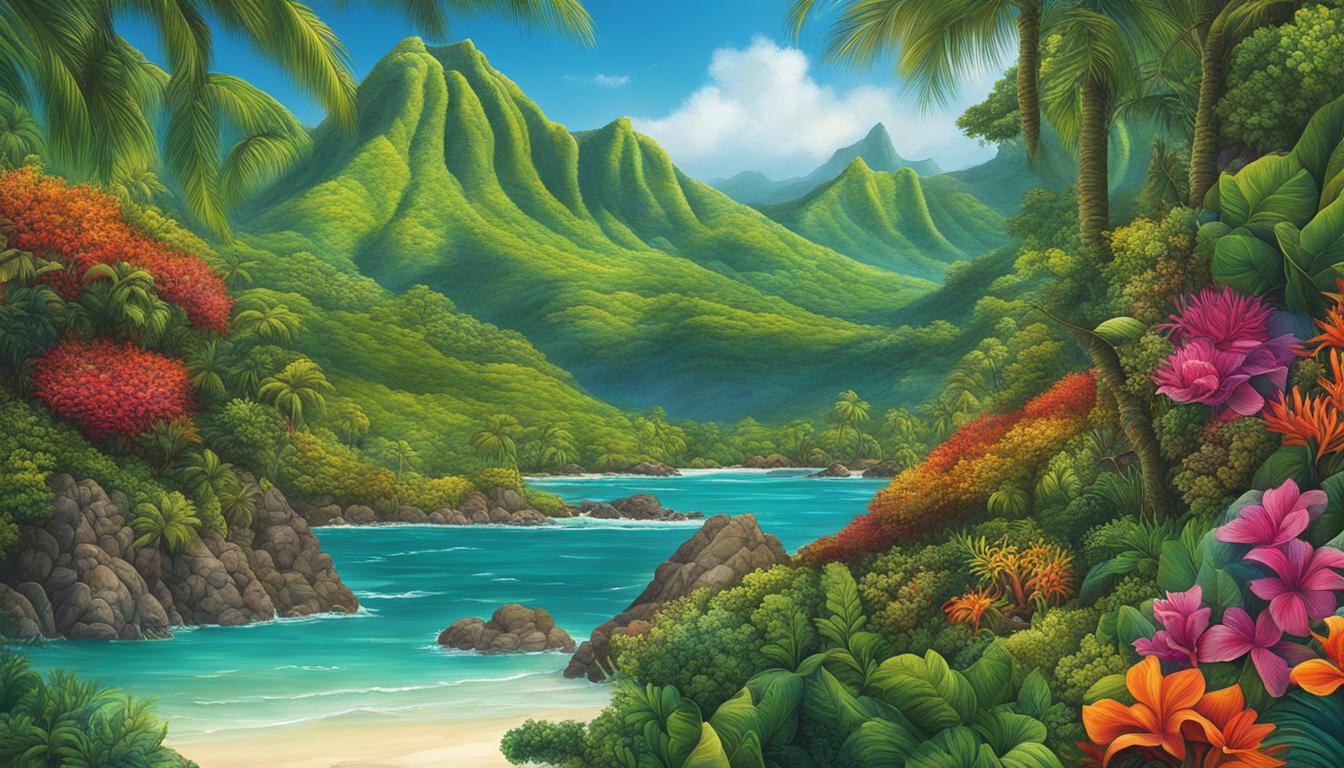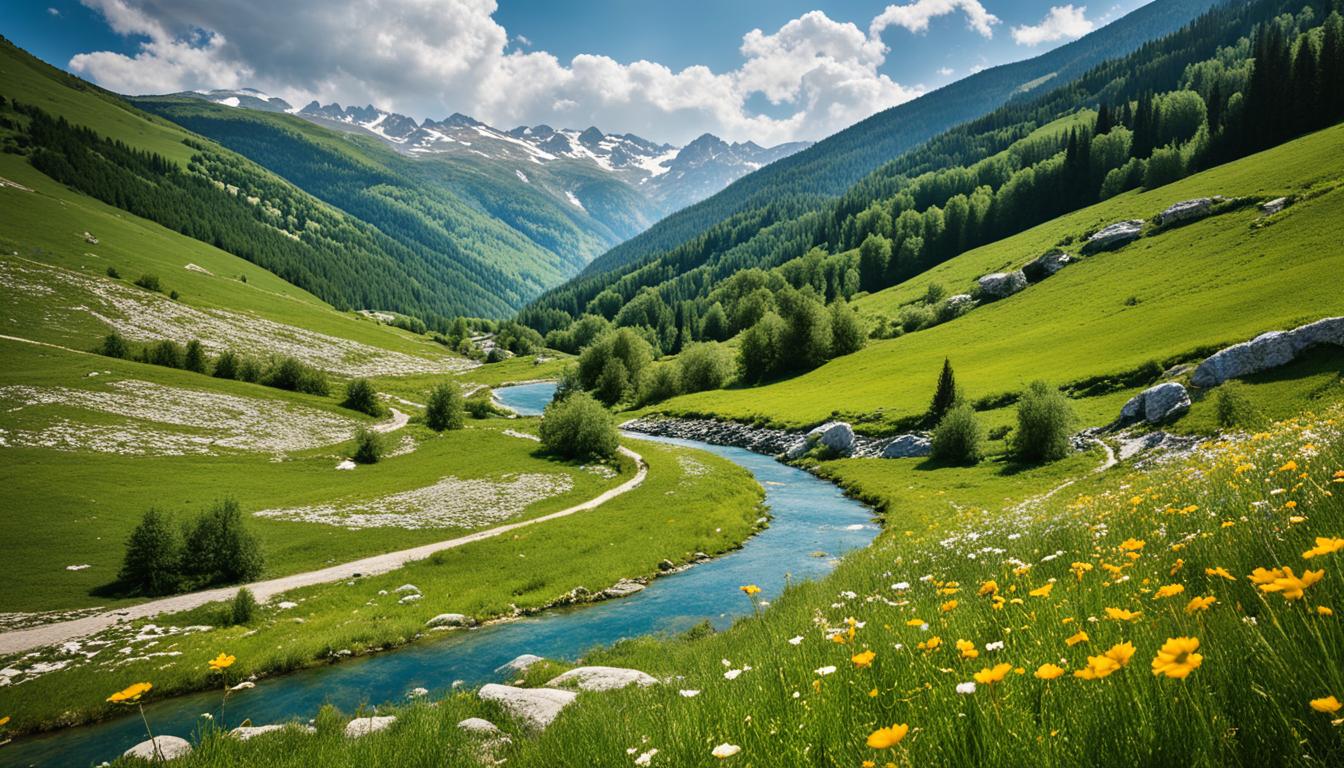United Arab Emirates Biodiversity and the Built Environment
The United Arab Emirates (UAE) is known for its stunning landscapes and rich biodiversity, with over 800 species of plants, 48 species of mammals, 440 species of birds, 72 species of reptiles and amphibians, and more than 40 species of coral reefs. These diverse ecosystems, including desert, mountain, and coastal habitats, are home to a wide array of unique wildlife. However, the UAE’s biodiversity faces various threats including habitat loss, climate change, and invasive species.
In order to protect and preserve the UAE’s precious biodiversity, sustainable development practices, green building techniques, and eco-friendly architecture play a vital role. Additionally, urban biodiversity conservation and sustainable urban planning are essential for creating harmonious environments where both humans and nature can thrive. The UAE is also dedicated to wildlife preservation efforts and environmental sustainability to promote the long-term well-being of its ecosystems.
Key Takeaways:
- The UAE is home to diverse ecosystems and rich biodiversity.
- Habitat loss, climate change, and invasive species pose significant threats to UAE biodiversity.
- Sustainable development, green building practices, and eco-friendly architecture are crucial for protecting UAE biodiversity.
- Urban biodiversity conservation and sustainable urban planning are important for creating harmonious environments.
- The UAE is dedicated to wildlife preservation efforts and environmental sustainability.
Importance of Biodiversity in the UAE
Biodiversity, often referred to as the variety of life on Earth, plays a crucial role in the United Arab Emirates (UAE) and its ecosystems. The UAE’s biodiversity encompasses a wide range of species, habitats, and ecosystems, making it a valuable asset to the country’s sustainable development and well-being.
Biodiversity in the UAE provides numerous benefits and essential services that contribute to the overall functioning of its ecosystems. Firstly, it plays a significant role in supporting food supply and agricultural productivity. A diverse range of plant and animal species ensures the availability of various food sources and contributes to overall food security in the country.
Additionally, biodiversity in the UAE is integral to the production of building materials. Many traditional construction practices in the UAE rely on local materials derived from plants and natural resources. The use of sustainable, locally sourced materials preserves biodiversity and supports eco-friendly architecture in the region.
Biodiversity also plays a crucial role in climate regulation. Various species are essential for maintaining the balance of greenhouse gases and mitigating climate change. Forests, for example, act as carbon sinks, absorbing and storing significant amounts of carbon dioxide, a greenhouse gas that contributes to global warming. Preserving the UAE’s biodiversity safeguards these natural carbon sinks and helps combat climate change.
Moreover, biodiversity supports soil fertility renewal and disease control. A rich variety of plant and microbial species contribute to the health and fertility of soils, enhancing agricultural productivity and nutrient cycling. Various organisms also play a vital role in controlling pests and diseases, reducing the need for harmful pesticides and promoting ecological balance.
Another crucial aspect of the UAE’s biodiversity is its genetic resources. The country is home to unique species that possess genetic traits with significant potential for scientific and medical discoveries. Studying and preserving these genetic resources allows for the development of sustainable and innovative solutions to pressing challenges in various fields.
Aside from its ecological benefits, the UAE’s biodiversity also contributes to the preservation of cultural heritage. Species like the Arab Falcon and camels hold significant cultural importance and have been deeply intertwined with the UAE’s identity for centuries. Protecting these species and their habitats allows for the continuation of traditional practices and cultural appreciation.
Preserving and conserving the UAE’s biodiversity is essential for the country’s sustainable development and the well-being of its people. By integrating environmental considerations into development practices, the UAE can strike a balance between economic growth and ecological preservation, ensuring a prosperous and harmonious future.
| Benefits of Biodiversity in the UAE | Sustainable Development | United Arab Emirates Ecosystems |
|---|---|---|
| Food supply | Building materials | Climate regulation |
| Soil fertility renewal | Disease control | Genetic resources |
| Cultural heritage preservation |
Preserving the UAE’s Biodiversity for a Sustainable Future
The UAE recognizes the importance of biodiversity conservation and has implemented various measures to protect and sustain its unique ecosystems. These efforts include the establishment of protected areas, national parks, and wildlife sanctuaries, as well as the implementation of conservation programs.
By prioritizing the conservation of biodiversity and integrating sustainability into development practices, the UAE can ensure the long-term well-being of its ecosystems, support sustainable economic growth, and preserve its cultural heritage for future generations.
The Value of Biodiversity
Biodiversity is of immense value, providing a multitude of ecosystem services that are crucial for human well-being and the proper functioning of our planet. The United Arab Emirates (UAE) is blessed with a rich biodiversity that offers various benefits to its environment, economy, and society. Let’s explore the different ways in which biodiversity contributes to the UAE’s prosperity.
“Biodiversity is fundamental to the functioning of ecosystems and provides essential services for sustaining life on Earth.” – United Nations Environment Programme (UNEP)
Ecosystem Services
- Food supply: UAE biodiversity plays a vital role in ensuring a diverse and sustainable food supply. Native plants and animals provide resources for agriculture, aquaculture, and fishing industries, contributing to local and traditional cuisine.
- Building materials: The UAE’s diverse flora offers a variety of plants that are used for construction, such as timber, bamboo, and thatch. These natural materials are not only eco-friendly but also support local livelihoods.
- Climate regulation: Biodiversity helps regulate the climate by maintaining ecological balance and reducing the impacts of climate change. Forests, wetlands, and other ecosystems absorb carbon dioxide, mitigate flooding, and stabilize local weather patterns.
- Soil fertility renewal: The UAE’s biodiversity promotes soil health and fertility through processes like nutrient cycling, organic matter decomposition, and nitrogen fixation. This enables the cultivation of crops and supports sustainable agriculture.
- Disease control: Biodiversity provides natural defenses against diseases. Natural predators, such as insects and birds, help control pest populations, reducing the need for harmful pesticides and promoting a healthier environment.
- Genetic resources: The UAE’s biodiversity holds valuable genetic resources that have the potential for significant scientific and medical discoveries. These genetic materials can be used for biotechnology, drug development, and crop improvement.
The UAE’s flora and fauna are not only valuable for their ecological roles but also deeply intertwined with its cultural heritage. They serve as symbols of significance and traditional practices, enriching the country’s cultural identity. For instance, the Arab Falcon represents nobility and companionship, while camels are essential for transport, milk, and racing.
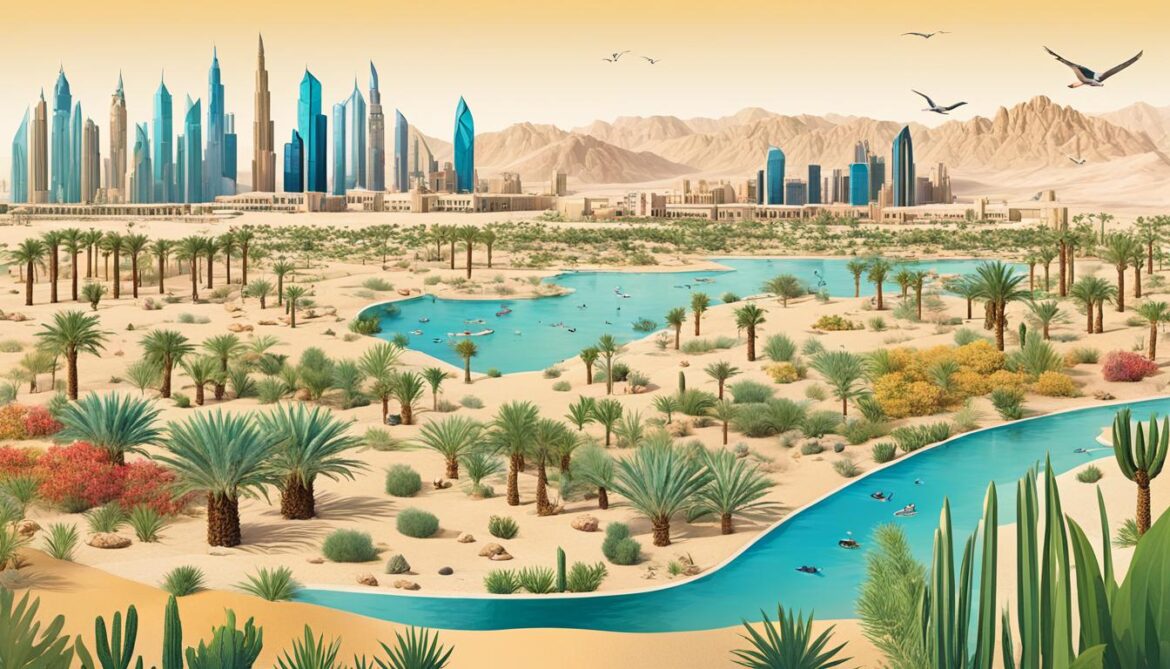
Biodiversity value extends beyond ecological benefits, encompassing cultural and societal aspects. By recognizing and preserving the UAE’s biodiversity, we protect the foundations of our environment, culture, and future development.
Cultural Significance of Biodiversity in the UAE
The United Arab Emirates (UAE) has a strong cultural connection to its natural surroundings, with biodiversity playing a central role in shaping its identity. In particular, species like the Arab Falcon and camels hold significant cultural value, symbolizing strength, nobility, resilience, and companionship.
The Arab Falcon has long been revered in Emirati culture, embodying the qualities of power, grace, and agility. Falcons are not only admired for their hunting prowess but also serve as companions to falconers, forging a deep bond between humans and these majestic birds. The traditional practice of falconry has been passed down through generations and continues to be cherished as an important cultural heritage.
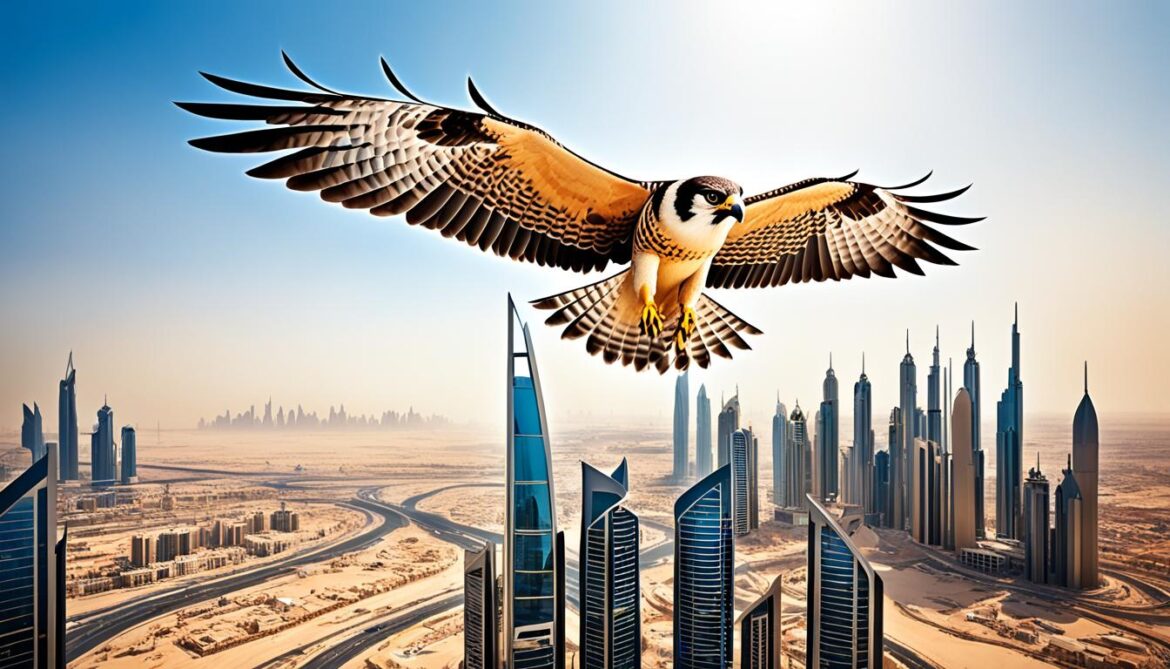
Similarly, camels have played an integral role in the history and daily lives of Emiratis. Their ability to survive in the harsh desert environment has made them invaluable for transportation, carrying goods across vast distances. Camel racing, another traditional practice, showcases the strength and speed of these magnificent creatures and is a cherished sporting event in the UAE.
Beyond their practical uses, the Arab Falcon and camels represent the heritage and resilience of Emirati culture. Their presence in the natural landscape serves as a reminder of the country’s deep-rooted connection to its desert roots and the importance of preserving its biodiversity for future generations.
The cultural significance of biodiversity in the UAE extends beyond individual species, encompassing the traditional practices and values that have shaped Emirati identity for centuries.
By conserving the UAE’s biodiversity, not only are natural resources protected, but the cultural heritage and traditional practices associated with species like the Arab Falcon and camels are also preserved. This recognition of the inseparable link between nature and culture underscores the importance of sustainable practices and the integration of biodiversity conservation into the fabric of Emirati society.
Conservation Efforts in the UAE
The United Arab Emirates recognizes the importance of preserving its diverse biodiversity and is committed to implementing various conservation efforts. In order to maintain critical habitats and provide refuge for endangered species, the government has established protected areas, wildlife sanctuaries, and national parks throughout the country. These areas play a crucial role in safeguarding the UAE’s unique and fragile ecosystems, ensuring the continued existence of its rich wildlife and plant species.
The UAE’s dedication to conservation extends beyond its borders, as it actively participates in several international environmental agreements. By partnering with the global community, the UAE demonstrates its commitment to protecting not only its own biodiversity but also promoting conservation efforts worldwide.
Conservation programs in the UAE are multifaceted and comprehensive. They focus on habitat restoration, captive breeding, public awareness and education, and scientific research. Through habitat restoration projects, the UAE aims to restore and enhance degraded ecosystems, ensuring the long-term sustainability of its biodiversity. Captive breeding programs provide a lifeline for endangered species, allowing for their populations to recover and thrive. Public awareness and education initiatives actively engage the local community in conservation efforts, raising awareness about the importance of biodiversity and the role individuals can play in protecting it. Finally, scientific research contributes to the understanding of UAE ecosystems, providing valuable knowledge for effective conservation strategies.
“Conservation is not merely a responsibility, but also an opportunity for innovation and sustainable development. Through our efforts, we can protect our natural heritage for future generations and ensure the well-being of both people and wildlife.”
Conservation Success Story: Arabian Oryx
One notable success story of conservation efforts in the UAE is the Arabian oryx. This iconic species was once on the brink of extinction, with only a few individuals remaining in the wild. Through a combination of captive breeding programs and reintroduction efforts, the Arabian oryx population has made a remarkable recovery. Today, these majestic creatures can be seen roaming freely in protected areas such as the Arabian Oryx Sanctuary in Abu Dhabi. This achievement highlights the effectiveness of targeted conservation measures and serves as an inspiration for ongoing efforts to protect other endangered species in the UAE.
| Conservation Efforts | Objective |
|---|---|
| Protected Areas | To maintain critical habitats and provide refuge for endangered species |
| Wildlife Sanctuaries | To protect and preserve specific habitats and species |
| National Parks | To promote the conservation of biodiversity and provide recreational opportunities |
| Conservation Programs | To restore habitats, implement captive breeding programs, raise awareness, and conduct scientific research |
The conservation efforts in the UAE are vital for the preservation of its unique biodiversity. By protecting the UAE’s natural heritage, these efforts contribute to the sustainable development of the country, ensuring a harmonious coexistence between humans and nature. Through ongoing conservation programs and public engagement, the UAE is taking proactive steps to safeguard its biodiversity for future generations.
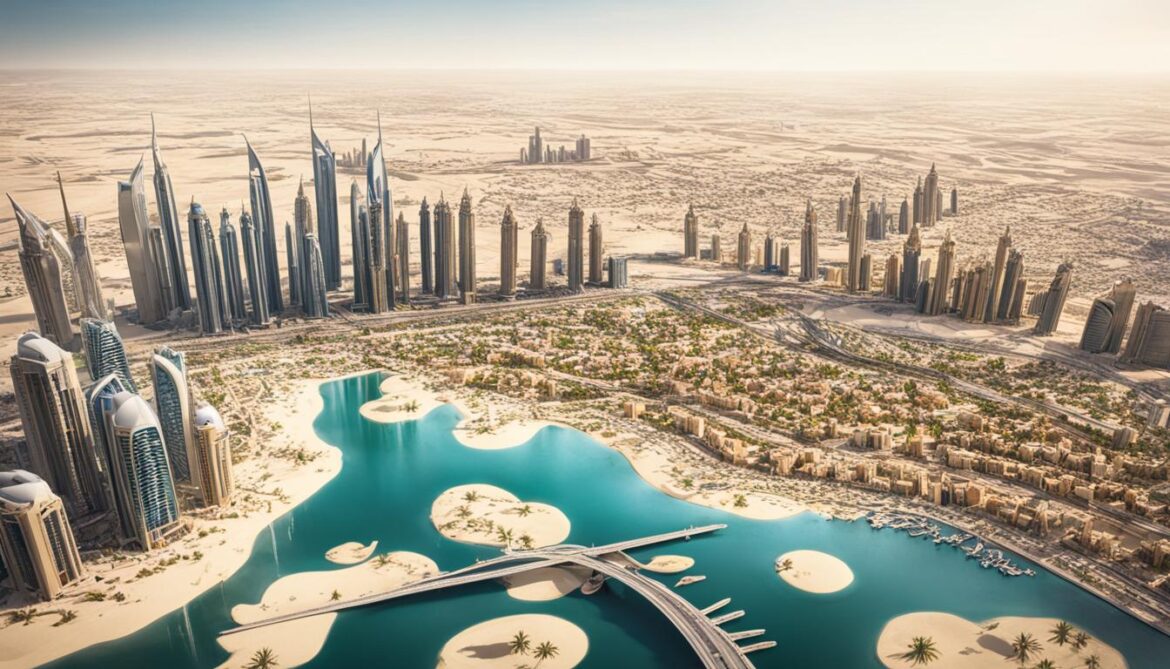
United Arab Emirates Terrestrial Biodiversity
The United Arab Emirates (UAE) is widely known for its remarkable terrestrial biodiversity, characterized by diverse ecosystems encompassing both desert and mountain habitats. The UAE’s desert ecosystem is particularly extraordinary, housing a wide range of unique plant species that have expertly adapted to the harsh climatic conditions. These desert plants not only survive but also thrive, providing vital sources of grazing and fodder for the region’s wildlife.
Desert Ecosystem: A Haven for Resilient Plant Life
In the UAE’s desert ecosystem, plant species have evolved specialized adaptations, such as deep root systems to tap into underground water sources, waxy cuticles to minimize water loss, and thorny structures for protection against herbivores. Some notable desert plant species in the UAE include the Ghaf tree (Prosopis cineraria), the Arabian myrrh (Commiphora gileadensis), and the desert tamarisk (Tamarix aphylla).
The desert plants not only play a crucial role in the ecological balance of the UAE but also hold significant cultural and economic value. They have long been utilized for medicinal purposes, traditional practices, and as a source of food and shelter by the indigenous communities of the region.
Mountain Ecosystem: A Diverse Array of Wildlife
The UAE’s mountain ecosystem is equally captivating, harboring a diverse array of wildlife. This includes mammals such as Arabian leopards (Panthera pardus nimr), Arabian tahr (Arabitragus jayakari), and the mountain gazelle (Gazella gazella), along with reptiles and birds that have adapted to the rugged mountainous terrain.
The mountains provide essential habitat for these species, offering ample food sources, shelter, and nesting sites. The UAE’s mountain ecosystem not only supports a vibrant wildlife population but also offers breathtaking natural landscapes that attract both locals and tourists.

Preserving Wildlife Diversity and Protecting Threatened Species
Despite the remarkable biodiversity within the UAE, several species in the region are currently facing the threat of extinction. Factors such as habitat loss, climate change, and human activities pose significant challenges to the survival of these species.
Efforts are underway to protect and conserve the terrestrial biodiversity of the UAE. Conservation organizations, along with the government, have implemented various initiatives, including the establishment of protected areas, wildlife corridors, and ecological restoration projects. These efforts aim to safeguard critical habitats, promote sustainable land-use practices, and raise awareness about the importance of wildlife conservation.
“Protecting the UAE’s terrestrial biodiversity is not only crucial for preserving the unique ecosystems but also for sustaining the delicate balance between nature and human development.”
By prioritizing the conservation of threatened species and their habitats, the UAE is taking significant steps towards safeguarding its terrestrial biodiversity for future generations. These conservation endeavors contribute to maintaining the ecological integrity of the region, preserving wildlife diversity, and supporting sustainable development in the United Arab Emirates.
United Arab Emirates Marine Biodiversity
The United Arab Emirates (UAE) boasts a unique and vibrant marine ecosystem along its extensive coastline, spanning approximately 2390 km. This coastal and marine ecosystem encompasses a diverse range of habitats, including coral reefs, seagrass beds, mangroves, and offshore islands, which collectively contribute to the remarkable marine biodiversity found within the UAE.
Coral reefs, in particular, play a pivotal role in supporting and sustaining a high level of biodiversity within the UAE’s marine environment. These delicate ecosystems provide vital habitats and nurseries for numerous marine organisms, such as fish species, marine mammal species, and various other marine life forms, ensuring the overall ecological balance and functionality of the marine ecosystem.
However, the marine biodiversity in the UAE faces significant threats and challenges that jeopardize its existence and sustainability. Climate change, pollution, overfishing, and habitat destruction pose grave dangers to the delicate marine ecosystems and the diverse array of species inhabiting them. These threats necessitate urgent conservation efforts and proactive measures to protect and preserve the marine biodiversity in the UAE.
Conservation efforts are paramount in safeguarding the UAE’s marine biodiversity. By implementing proactive conservation strategies, we can mitigate the threats posed to these fragile ecosystems and create sustainable solutions for the future. These efforts include:
- Establishing marine protected areas
- Implementing sustainable fishing practices
- Reducing pollution through strict regulations
- Promoting public awareness and education
- Supporting scientific research and monitoring initiatives
With focused conservation efforts, we can protect and preserve the UAE’s marine biodiversity for future generations to come, ensuring the long-term sustainability of these unique ecosystems. By recognizing the value and importance of our coastal and marine environments, we can contribute to the overall health and well-being of our planet.
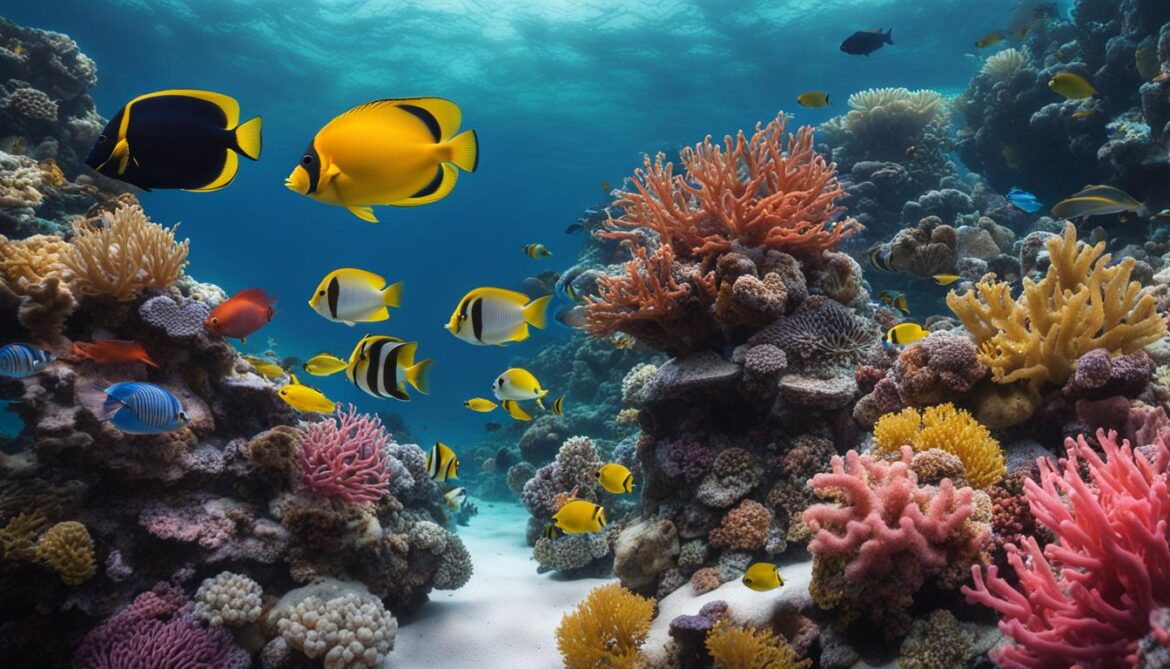
Key Statistics: UAE Marine Biodiversity
| Marine Habitats | Number of Species |
|---|---|
| Coral Reefs | Over 200 species of coral |
| Seagrass Beds | Approximately 13 species of seagrass |
| Mangroves | More than 70 species of mangroves |
| Offshore Islands | Various species of birds, reptiles, and marine mammals |
Endangered Species and Conservation Efforts
Several species in the United Arab Emirates are currently endangered, including the Arabian oryx, Arabian leopard, and Arabian gazelle. These species face numerous threats to their survival, such as habitat loss, hunting, and fragmentation.
To protect these endangered species, the UAE has implemented various conservation measures. One of the key initiatives is the establishment of protected areas that serve as safe havens for these vulnerable animals. These protected areas provide undisturbed habitats where these species can thrive and reproduce, away from the pressures of human activities.
In addition to protected areas, the UAE has also implemented captive breeding programs for endangered species. These programs aim to breed and raise endangered animals in controlled environments, with the goal of increasing their population size and reintroducing them into the wild. By carefully managing these captive populations, conservationists can prevent the loss of genetic diversity and improve the chances of survival for these species.
Habitat restoration is another critical component of conservation efforts in the UAE. By rehabilitating degraded habitats and restoring their natural features, conservationists create suitable conditions for the recovery of endangered species. This involves activities such as reforestation, removing invasive species, and implementing sustainable land management practices that enhance biodiversity and improve ecosystem health.
The UAE is also actively involved in anti-poaching initiatives to combat the illegal trade of endangered species. This involves rigorous law enforcement measures, raising public awareness about the consequences of wildlife poaching, and collaborating with international organizations to dismantle wildlife trafficking networks.
Although significant progress has been made, more action is needed to ensure the long-term survival of these endangered species. Conservation organizations and government agencies continue to work together to strengthen existing conservation measures, implement new strategies, and engage local communities in protecting the UAE’s biodiversity. The ultimate goal is to promote a harmonious coexistence between humans and nature, safeguarding the remarkable diversity of life for future generations.
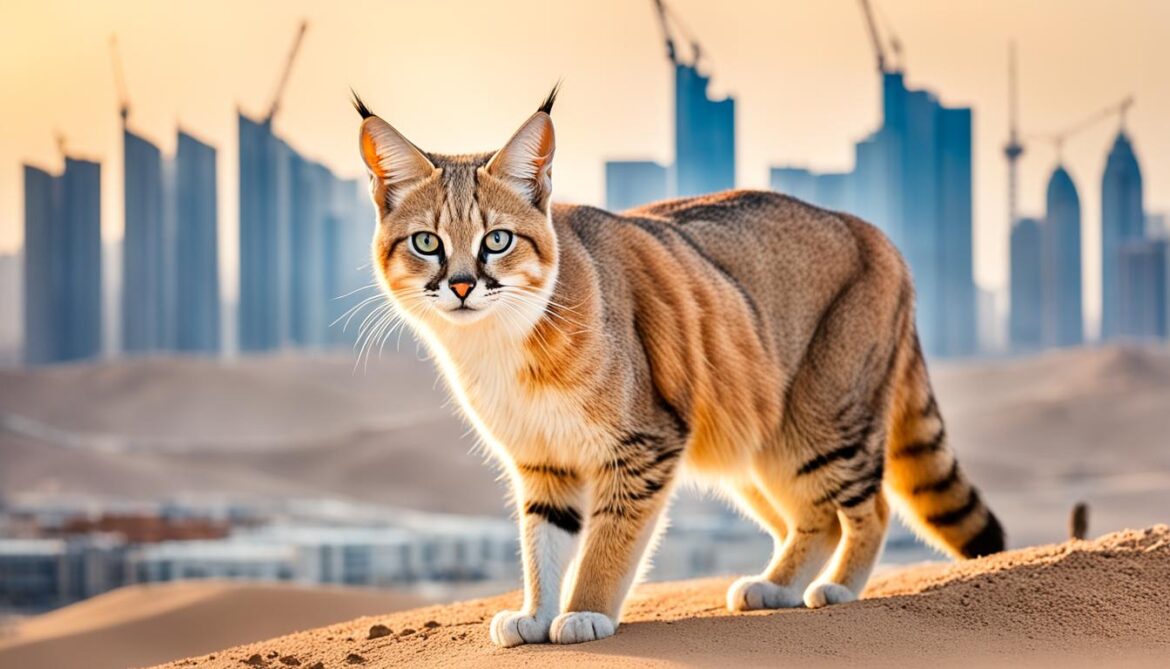
Conclusion
The United Arab Emirates (UAE) boasts a rich and diverse collection of animal and plant species, thriving in its unique ecosystems spanning various habitats including deserts, mountains, and coastlines. However, this precious UAE biodiversity is under siege from habitat loss, climate change, and invasive species. To safeguard the country’s ecosystems, economy, and cultural heritage, it is imperative that comprehensive conservation efforts and sustainable development practices are adopted. By protecting and preserving UAE biodiversity, we secure not only our natural resources but also safeguard our cultural heritage for generations to come.
Conservation initiatives in the UAE are vital in ensuring the survival and well-being of our ecosystems. From establishing protected areas, wildlife sanctuaries, and national parks to implementing habitat restoration efforts and conservation programs, the UAE is committed to the preservation of its diverse biodiversity. Additionally, the UAE actively participates in international environmental agreements, underscoring its dedication to the global conservation movement. By championing these efforts, we enhance the resilience of our ecosystems and protect endangered species, while promoting sustainability in our practices.
Preserving UAE biodiversity is a crucial step towards sustainable development. The well-being of our ecosystems, including the services they provide such as food supply, climate regulation, and disease control, directly impacts our communities and economy. Moreover, our cultural heritage is intricately intertwined with our flora and fauna, which represent symbols of importance and traditional practices. By safeguarding UAE biodiversity, we nurture our cultural identity, protect our natural resources, and forge a harmonious relationship between humans and nature.
In conclusion, the United Arab Emirates recognizes the immense value of its biodiversity and the need for its conservation. With concerted and continuous efforts towards protecting UAE bio-diversity, promoting sustainable development, and championing conservation initiatives, we can ensure the well-being of our ecosystems, preserve our cultural heritage, and build a future that is harmonious with nature.




